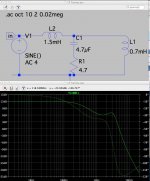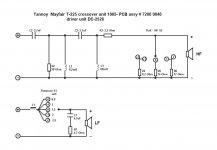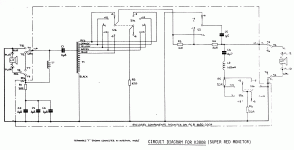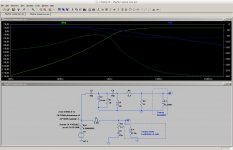for K3808/9 squawker it's somewhere in range of 0.8mH , if memory serves me well , measured with my trusty Russian Gizmo
dunno - it seems it's time again that you dismantle one driver from box
dunno - it seems it's time again that you dismantle one driver from box

find enclosed sim of Mayfair xover , but we need few things pronto :
- inductance of squawker
- Rdc of L3 (it's critical ) (ref to enclosed schm , you sent me previously)
while you are there ( presumably with driver out and xover semi-dismantled) , measure Rdc of other chokes and take few pictures
what I'm pretty sure is that best solution will be sort of K3808 xover ( for Super Red monitor ) , with higher Fo ; fact is that squawker is the same , needing "regular" Pepperpot 3K notch and also Newman Eq ........
no need for autoformer ( and missing 1.5db , as in case with 15" cone)
that later .....
or - find enclosed that too , just for fun ......
- inductance of squawker
- Rdc of L3 (it's critical ) (ref to enclosed schm , you sent me previously)
while you are there ( presumably with driver out and xover semi-dismantled) , measure Rdc of other chokes and take few pictures
what I'm pretty sure is that best solution will be sort of K3808 xover ( for Super Red monitor ) , with higher Fo ; fact is that squawker is the same , needing "regular" Pepperpot 3K notch and also Newman Eq ........
no need for autoformer ( and missing 1.5db , as in case with 15" cone)
that later .....
or - find enclosed that too , just for fun ......
Attachments
Last edited:
don´t bum…. me…… 😀
here come the missing values….
squawker Re= 9R5 (!) and L = 0.21mH
L3 Re = 0R7 and 0.8mH
L2 Re = 0R7 and 0.2mH
the reason that the L2 has the same resistance value is that the L2 coil has no core and seems to have the same length than the L3 with core.
🙂
here come the missing values….
squawker Re= 9R5 (!) and L = 0.21mH
L3 Re = 0R7 and 0.8mH
L2 Re = 0R7 and 0.2mH
the reason that the L2 has the same resistance value is that the L2 coil has no core and seems to have the same length than the L3 with core.
🙂
When the foam hit the market nobody knew that it would rot over time. When that became clear Tannoy re-introduced butyl rubber and paper accordion surrounds with the K series.
Foam is the worst as far as long term reliability is concerned, but definitely the best sounding. Especially the kind of thin foam that was doped used by Tannoy proved to be relatively long lasting (20+ years) if the speaker was not used in very bad climate.
Last edited:
The really funny thing is that in the '70s and '80s when Tannoy still employed that autoformer people bent over backwards to get rid of the it as it was seen as detrimental to the sound quality and now the next generation of audiophools is desperate to get it back. Seems to be all about nostalgia rather than anything else and one has to question the current crop of audiophools listening ability.
If some kind of HF adjustment is needed at all, autoformer is probably better solution than L-pad or resistor voltage divider. Tannoy used it in some cheap studio monitors (Reveal) insted of voltage divider without adjustment possibility, just single secondary tap. The BIG problem with autoformer with adjustment was switch contacts. But very simple measure was needed to keep it clean: switch it back and forth once each day and they will work just fine forever! Also switch it while playing at some substantial spl and the arcing will clean it. (These solutions are necessary as it is very difficult to open switch for cleaning)
Last edited:
Personally I have no horse in that particular race as I use my Tannoys active.
I am merely relaying information from a conversation I had with Roger at Lockwood Audio some years ago.
These days a popular modification is to bypass the switches in your favoured setting.
I am merely relaying information from a conversation I had with Roger at Lockwood Audio some years ago.
These days a popular modification is to bypass the switches in your favoured setting.
I had MY Tannoys as Active.
Using a Bespoke Crossover painstakingly built from Tannoy Group design input.
With the best of components and little if any effort spared.
Truth is the OEM passive (upgraded with fresh bits).. works EVERY bit as well.
Arguably better, imo
Which is Why I switched back to a passive..
Sooo much talk and so little substance.
Gotta Love Audio Weenies.
Using a Bespoke Crossover painstakingly built from Tannoy Group design input.
With the best of components and little if any effort spared.
Truth is the OEM passive (upgraded with fresh bits).. works EVERY bit as well.
Arguably better, imo
Which is Why I switched back to a passive..
Sooo much talk and so little substance.
Gotta Love Audio Weenies.
THX Zen Mod, I will try it!
😛
😛
G.
something like this
trying first with parts from drawer
I had MY Tannoys as Active.
Using a Bespoke Crossover painstakingly built from Tannoy Group design input.
With the best of components and little if any effort spared.
Truth is the OEM passive (upgraded with fresh bits).. works EVERY bit as well.
Arguably better, imo
Which is Why I switched back to a passive..
Sooo much talk and so little substance.
Gotta Love Audio Weenies.
good to hear!
😀
- Status
- Not open for further replies.
- Home
- Loudspeakers
- Multi-Way
- The Tannoy Story by Julian Alderton ??!



